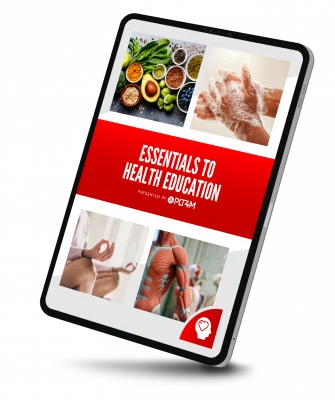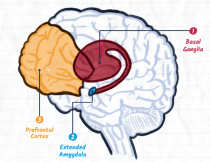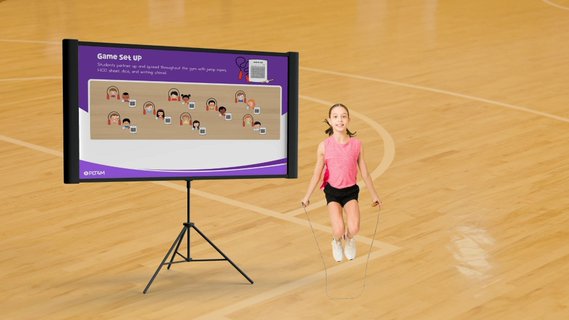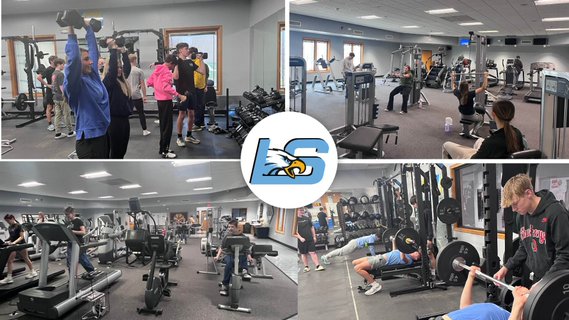Health education is a vital component of a well-rounded curriculum, as it provides students with the essential knowledge and skills needed to maintain and improve their health, prevent disease, and reduce risky behaviors. Health education lesson plans complement the physical education curriculum to put together the complete picture of health and wellness for students. After exploring health education lesson plans at a high level, we provide 5 free health education lesson plans from a wide range of topics.
What Are Health Education Lesson Plans?
Health education lesson plans cover a wide array of topics designed to promote students’ physical, mental, and emotional well-being. As most teachers set out to find health education lesson plans, they are often in search of resources and information on health topics like:
Nutrition and Healthy Eating Habits
Physical Activity and Exercise Programs
Mental Health Education (Stress Management, Coping Mechanisms, Mindfulness)
Substance Abuse Prevention (Drugs, Alcohol, Tobacco, etc.)
Sexual Health Education (Reproductive Health, Contraception, STIs)
Personal Hygiene and Disease Prevention
And these health topics aren’t even an exhaustive list. There are so many different avenues health and physical educators can take when teaching health information to students.
Challenges of Teaching Health Education
Teaching health education is a challenging and rewarding field. Health and physical educators are on the front lines for providing resources and information to students on practicing healthy habits throughout their lives.
But talking about health topics with young people can be tricky and sometimes uncomfortable! What type of health education lesson plans can convey key topics and ideas while keeping students engaged in class?
Finding quality health education lesson plans is a complex task! Getting suitable instructional materials that will engage and excite your students while not breaking the bank is hard!
First, textbooks and hard-copy materials might be excellent now, but the ever-changing world of health education can quickly make these options outdated and unusable. Next, if you search online, you might find specific health education lesson plans on a topic, but they only cover some of what you need to teach and introduce to students.
Finally, finding age and grade-appropriate resources for different students can be challenging no matter what option you search for. In addition, schools look to align any health education lesson plans to the national health education standards.
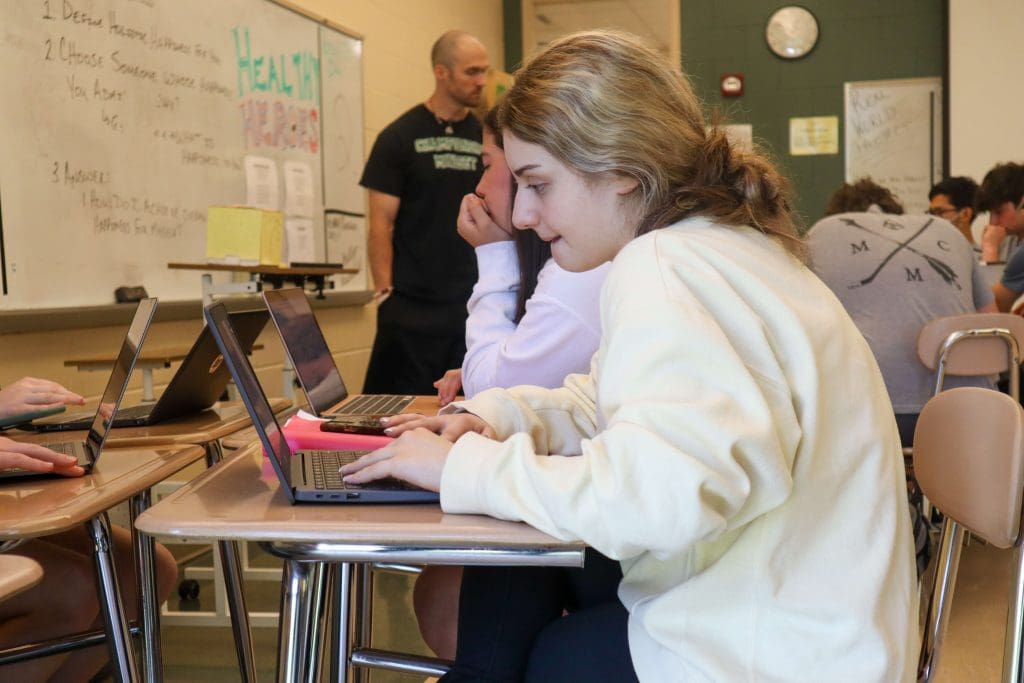
Make Health Education Lesson Plans Relevant!
For health education lesson plans to be effective, they need to be relevant and engaging for students. And most importantly, health education lesson plans need to responsive to the ever changing world our young people live in.
For example, nutrition education shouldn’t give a one-size-fits-all prescriptive solution on eating and healthy habits. Students navigate nutrition based on a wide variety of factors including family, culture, socioeconomics and more. Giving restrictive calorie guidelines and defining foods as “good” and “bad” will only confused students. Therefore, nutrition lesson plans should provide solid foundational information on nutrition and how it can then be applied to students individual health and wellness journeys.
We can use the nutrition example and apply it to almost any of our health education lesson plans. By taking a 21st century approach, we can educate and inform students to be decision makers, rather than creating a black and white world where students are feeling like if they aren’t ‘perfect’ people, then they have failed completely.
What does that look like for health education lesson plans? Check out 5 free health education lesson plans from PLT4M below to see!
Get Our FREE Health E-Book!
The Essentials to Health Education
Get five free health lessons, pulled directly from our Health Curriculum. With lessons on Nutrition, Digital Citizenship, Personal Hygiene and more, there are tons of valuable insights!
5 Free Health Education Lesson Plans
Below are 5 free health education lesson plans from PLT4M. Over 1,000 schools use PLT4M as their go to resource, curriculum, and technology for physical activity and health. Each lesson comes fully loaded with a short video, written lesson, and guiding chapter questions. The 5 free health education lesson plans below come from the following programs within PLT4M’s comprehensive web resource:
1) Nutrition – Needs For Growing Students
We all come to nutrition education with different life experiences, backgrounds, and expectations! Over the 13 chapters, we break down the basics, debunk myths and misconceptions society has thrown out there about nutrition, and give you the tools to navigate your own nutritional experience. This is a sample from chapter 1 of PLT4M’s nutrition lesson plans unit.
Overview:
Food. Everybody’s doing it. Every human on this planet consumes food (this includes water). Like sleep, feeding and hydrating the human body is absolutely essential. We can survive without television, cars, and smartphones, but not food.
Food provides energy to think, breathe, grow, move, repair, and heal. Food also provides non-energy vitamins and minerals that support essential activities like converting food to energy, developing hormones, supporting the immune and nervous systems, and protecting our body from damage.
While we all eat food, the what, where, why, when, and how can vary dramatically based on various lifestyle factors. Culture, environment, and emotions among other factors can greatly influence what we consume on a daily basis.
The human body does best with a mixture of foods. The food groups and plate method are one approach to understand how to meet those needs (eg, fruits, vegetables, grains, dairy, proteins etc). And most bodies have a preference to replenish fuel regularly – typically every 3-5 hours.
Nobody’s Perfect:
But in reality, we often don’t eat “perfectly,” and that’s ok. The human body is resilient and flexible. It doesn’t require 100% perfection in order to function. The body doesn’t have a daily deadline for its needs. Instead, it looks at nutrition as an average over time. It can tolerate and do “just fine” with less than optimal food choices or increased space between meals.
In fact, despite what you see on social media and in documentaries, the only foods you absolutely should not eat are foods that are expired / moldy, that you’re allergic to, or need to be avoided due to a medical condition. Beyond that, there are infinite ways to eat well.
Surviving or Thriving?
But there is a spectrum between “surviving” (just meeting the bare minimum for nutrients) and “thriving” (optimal fueling for performance). The mission with nutrition is to find a balance between giving your body the foods (and nutrients) it needs to thrive while also making sure to include foods that are personally important to you, based on your taste buds, budget, cooking abilities, and culture.
At a bare minimum, every person needs to eat enough energy (aka, calories) each day for the body to function. Even when someone stops growing in height, their muscles, organs, bones, and brain are still developing. New evidence shows that growth and development may continue until the age of 25!
Running On Fumes:
Ideally, the goal is to continue to work towards finding ways to thrive with our nutrition. When we don’t give our bodies enough fuel, we enter “survival mode”. There are a laundry list of potential consequences that can occur when the body lacks the fuel it needs, such as:
-Difficulty concentrating, which reduces our ability to learn as effectively
-Increased irritability and anxiety
-Compromised height development
-Reduced athletic performance
-Reduced interest in and ability to reproduce
-Increased risk of injury
-Reduced bone strength
What’s Next?
Once a body has enough fuel, you can focus on the quality of the fuel going in. Defining “quality” can be controversial. What you see in the media, and put out by influencers and corporations is not always consistent with science (or realistic for a normal life).
The goal of Fuel 4 Fitness is to cut through the noise and give you the real-life tools and skills to decipher fact from fiction so you can make the best decisions for you.
In the next chapter, we’ll explore the chemistry of food and how it affects the human body. From there, we’ll talk about how to bring that chemistry to life!
2) Personal Hygiene – Washing Hands
Personal hygiene is the behaviors and steps that we can take as individuals to maintain health and prevent disease for ourselves, and the people around us. An added bonus of personal hygiene is that we make ourselves more enjoyable to be around in social situations of all kinds. In these lessons, we explore key concepts of personal hygiene for students to explore. While some of this might serve as a review, it can be helpful to all get on the same page about personal hygiene, especially as we hit our young adults years!
Handwashing is a simple yet highly effective practice that plays a crucial role in maintaining good health. Our hands are constantly in contact with various surfaces and objects, accumulating germs and bacteria throughout the day. It is a habit we learn from an early age, and while it may seem like a routine task, the impact it has on preventing the spread of infections and diseases is crucial. In this article, we will explore why washing hands is important, the science behind it, and the proper techniques to ensure effective hand hygiene.
All The Things We Touch
People touch a wide variety of surfaces and objects throughout the day, often without realizing the potential for germ transmission. Commonly touched items include doorknobs, light switches, elevator buttons, keyboards, smartphones, tablets, pens, pencils, and other school supplies.
In public spaces, individuals may come into contact with handrails, shopping carts, door knobs, and restroom fixtures.
At home, commonly touched items include remote controls, kitchen appliances, faucets, and light fixtures. Personal items like money, wallets, keys, and purses also frequently pass through hands.
And this is not an exhaustive list of things we touch! The diversity of surfaces encountered underscores the importance of regular hand washing to minimize the risk of spreading germs and prevent the transmission of infectious diseases.
How Germs Spread:
The CDC says thata few common times germs can spread from person-to-person or from surfaces-to-people include when you:
- Touch your eyes, nose, and mouth with unwashed hands
- Prepare or eat food and drinks with unwashed hands
- Touch surfaces or objects that have germs on them
- Blow your nose, cough, or sneeze into hands and then touch other people’s hands or common objects
Therefore, the CDC recommends washing hands during key times in the day to help minimize the threat of spreading germs:
- Before, during, and after preparing food
- Before and after eating food
- Before and after caring for someone at home who is sick with vomiting or diarrhea
- Before and after treating a cut or wound
- After using the toilet
- After changing diapers or cleaning up a child who has used the toilet
- After blowing your nose, coughing, or sneezing
- After touching an animal, animal feed, or animal waste
- After handling pet food or pet treats
- After touching garbage
5 Steps To Washing Your Hands The Right Way
Washing your hands is an easy and effective way to prevent the spread of germs to keep you and the people around you healthy! And while you might have “washed your hands” by turning on the faucet and letting your hands just get wet, the CDC outlines 5 key steps to washing your hands the right way every time:
Follow these five steps every time.
- Wet your hands with clean, running water (warm or cold), turn off the tap, and apply soap.
- Lather your hands by rubbing them together with the soap. Lather the backs of your hands, between your fingers, and under your nails.
- Scrub your hands for at least 20 seconds. Need a timer? Hum the “Happy Birthday” song from beginning to end twice.
- Rinse your hands well under clean, running water.
- Dry your hands using a clean towel or air dry them.
And while washing your hands with soap and water is the best way to get rid of germs, if this isn’t possible, hand sanitizer can be a helpful alternative. While hand sanitizers don’t get rid of all types of germs, hand sanitizer with at least 60% alcohol can help to reduce the risk of germ transmission.
Conclusion
In the battle against infectious diseases, handwashing stands out as a powerful and accessible tool to good hygiene and healthy living. By understanding the importance of hand hygiene and adopting proper handwashing techniques, individuals can contribute to their own well-being and the health of their communities. As a simple yet effective practice, regular hand washing serves as a cornerstone in the foundation of public health and disease prevention.
Helpful Links:
– Hand Hygiene – Keeping Your Hands Clean
– Frequent Questions About Hand Hygiene
Get Our FREE Health E-Book!
The Essentials to Health Education
Get five free health lessons, pulled directly from our Health Curriculum. With lessons on Nutrition, Digital Citizenship, Personal Hygiene and more, there are tons of valuable insights!
3) Mental Health – Stress Management
Understanding and navigating our emotions are essential skills for personal and interpersonal success. In this program, we tackle our emotions head-on through guided written and video instruction. Through this emotional journey, students will learn about the science of our different emotions and how they make us think and feel in our body and mind. From there, students will practice and develop skills and strategies to process and unpack our emotions in a healthy and productive way.
What is Mental Stress?
When we experience stress, our body’s “fight or flight” response is triggered. If you saw a bear in the woods, your brain would trigger a response system that we know as stress. The hypothalamus receives a signal from the amygdala and triggers the release of stress hormones, including adrenaline (epinephrine) and cortisol. These hormones prepare the body for action.
And while hopefully you aren’t running into too many bears in the woods, your body is still activating it’s stress response system, often over very small things. In fact, most of our thoughts that cause mental stress come from repetitive, negative, and useless thoughts.
While that might sound harsh, we all know that feeling of our heart rate rising as we start to think about an upcoming test or presentation, or even going to talk to that person you have a crush on. All sorts of questions and thoughts start to pop into your head about all the things that could go wrong. Remember, most of these are repetitive, negative, and useless!
What Causes You Mental Stress?
Mental stress can occur by a variety of different things. And for each one of us, there might be something or somethings that cause us to experience mental stress. It may be phones and social media. It may be social interactions at school. It could even just be something like worrying about what you are going to wear to school.
We often are embarrassed to share or even think to ourselves about the things that cause us mental stress. Even if they might seem repetitive, negative, and useless, in the moment of stress, they certainly don’t feel like that to us. Be kind and patient to yourself when you experience mental stress. Rather than avoiding it, let’s notice it and use skills and tools to address it.
While a little stress is a good thing, chronic stress can take a toll on our bodies and minds. Let’s explore a tool and skill that can help to unravel our repetitive, negative, and useless thoughts.
An important note! While a lot of our mental stress is caused by repetitive, negative, and useless thoughts, mental stress also occurs from traumatic and serious things. If we are worried about a sick loved one, money, or other things that impact our immediate lives, we should talk and work with someone we trust to help address and alleviate these issues if possible.
The Stop Method
So how do we break the loop of negative and repetitive thoughts? One of the best ways to break the loop is by focusing on our breath. This allows us to slow down and focus and break the pattern of mental stress.
Let’s take a look at the STOP method. By allowing your body to physically slow down, it can also help to mentally calm down.
The STOP Method: To wrap up the class and this lesson, let’s review the stop method.
S- Stop or pause and still your body.
T- Take deep breaths (in through your nose, out through your mouth. Feel your belly and chest fill with air).
O- Observe and notice how you feel. Any thoughts? Welcome them and allow them to be there.
P- Proceed. Continue on with what you are doing.
This STOP method can be just one minute. Notice how you feel when you practice this STOP technique. Are you more calm or focused? Or if you feel the same, that is okay! This takes practice and might not create an immediate fix. It takes time to grow in our meditation practice.
4) Drug Education – Drugs & The Brain
Different types of drugs and substances have a profound impact on the body and brain. This program invites students to take a scientific journey to learn about the body and brain’s complex responses to specific drugs and substances. In these lessons, we will explore the facts and science behind drugs and substances, with a breakdown of the short and long-term affects that they have.
All of this program’s written materials, videos, and PDFs are from the Mind Matters Series created by The National Institute of Drug Abuse (NIDA). All lessons are based on national science and education standards and were developed by scientists from leading universities and the National Institute on Drug Abuse.
Source: National Institute on Drug Abuse; National Institutes of Health; U.S. Department of Health and Human Services.
The human brain is a very complicated organ.
Your brain weighs three pounds and controls everything you do. You need your brain to see, hear, smell, taste, and feel. Your brain is you—everything you think and feel and who you are.
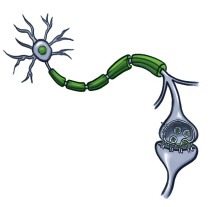
How does the brain work?
Our body has special cells called neurons that carry messages back and forth between the brain and other parts of the body. The neurons send messages to each other by releasing chemical substances called neurotransmitters into the gaps between cells. These gaps are called synapses.
The neurotransmitter crosses the synapse and attaches to a receptor on another reuron, like a key fits into a lock. This is how neurons talk to each other to make your brain and body do things. For example, when you want to walk up a flight of stairs, your brain sends a message to your feet to move, using long chains of neurons.
How do drugs work in the brain?
Drugs change the way that neurons talk to each other. These changes cause neurons to make you act in ways that you normally wouldn’t.
There are three main parts of the brain that are affected by drug use:
- The basal ganglia is the part of the brain that motivates us to do healthy activities, like eating or hanging out with friends. Drugs flow into this area of the brain and cause people to feel really happy. But if you use a drug a lot, the basal ganglia can get used to having the drug around, and make it hard to feel pleasure from anything but the drug.
- The extended amygdala is what makes you feel stressed out or cranky. When people use drugs, this part of the brain gets very sensitive. When your body is used to the drugs and you stop, the extended amygdala makes you feel really sick, so people will use drugs again just to get rid of that feeling.
- The prefrontal cortex helps you think, make decisions, and control your actions. So when someone uses drugs, this part of the brain becomes less able to make good judgements or step in to say “no” to a harmful impulse.
Also, some drugs affect other parts of the brain, like the brain stem. The brain stem controls heart rate and breathing. When a person takes certain drugs like opioids, their breathing can become dangerously slow. When the breathing stops, its called an overdose, and can cause death.
Why do people keep taking drugs when they know they’re bad for you?
Drugs change the brain in ways that make quitting hard, even when you want to. This is because when you take drugs, the neurotransmitter dopamine is released in the basal ganglia in large amounts. Dopamine signals in this brain area “teach” other parts of your brain to keep seeking out the drug so you can take it again and again.
When people can’t stop using drugs even though they want to, and drug use is causing serious consequences, it is called addiction. Their brain has learned to crave the drug all the time.
What are the long-term effects of drug use?
Drug use can lead to serious changes in the brain that affect how a person thinks and acts. It can also cause other medical problems, even death. Some drugs can cause heart disease, cancer, lung problems, and mental health conditions, like depression. A few drugs can even kill cells in your brain and body and make it hard to walk and talk and understand what’s happening around you.
What if someone I know needs help?
If you think a friend or family member has a problem with drugs, talk to an adult you trust – like a parent, coach, or teacher – right away. Remember, treatment is available and people can get better.
5) Sleep – Benefits Of Sleep
We all sleep. But we don’t always get the quantity or quality sleep needed to perform at our best. In this program, we dive into the fascinating realm of sleep science, exploring the intricacies of the sleep cycle and stages, the importance of circadian rhythms, and the profound impact that sleep has on your physical, mental, and emotional well-being. This program combines videos and written lessons to help students and athletes better understand concepts of sleep and how they can apply them to their day to day lives.
In the hustle and bustle of school and life, with assignments piling up, extracurricular activities demanding attention, and social lives buzzing, it’s easy to underestimate the importance of a good night’s sleep. However, there are a multitude of benefits of sleep, impacting not only your academic performance but also your overall health and well-being. We all need sleep and our body benefits physically, mentally, and emotionally. Let’s start out our sleep journey by understanding the benefits.
1. Enhanced Learning and Memory:
Imagine sleep as the secret ingredient to boosting your brainpower. During the deep sleep stages (more on this in future lessons), your brain is hard at work consolidating memories, organizing information, and making connections between new and existing knowledge. This means that a solid night’s sleep can significantly enhance your ability to learn and remember what you’ve studied, helping you perform better in school, work, and life. (1)
2. Improved Concentration and Focus:
Pay attention! Ever find yourself zoning out in class or struggling to concentrate during a study session? A lack of sleep might be the culprit. Lack of sleep can impair your cognitive function, making it difficult to pay attention and stay focused. But a well-rested mind, on the other hand, is alert, attentive, and ready to tackle the challenges of the day with vigor. (2)
3. Better Mental and Emotional Well-Being:
Ever had a bad night sleep and feel grumpy or agitated? A lack of sleep can take a major toll on our mental and emotional well-being. For example, lack of sleep has been linked to increased stress, anxiety, and irritability. Sleep plays a crucial role in regulating mood and emotional well-being. By prioritizing quality sleep, you can better manage the emotional rollercoaster of life and approach challenges with a more positive mindset. (3)
4. Physical Health and Immune System Support:
Beyond the mental benefits, sleep is essential for maintaining our physical health. During sleep, your body engages in repair and regeneration processes, strengthening the immune system and supporting overall well-being. Consistent, quality sleep is associated with a lower risk of illnesses and can help you recover faster if you do happen to get sick. (4)
5. Enhanced Physical Activity and Athletic Performance:
For the student-athletes among us, sleep is a critical factor in achieving peak performance. Sleep contributes to improved reaction times, faster recovery, and enhanced endurance. Consider sleep as a natural performance enhancer that can give you the edge in both sports and academics. And even if you aren’t a student-athlete, these benefits also help support our journey in fitness and physical activity. (5)
The Power Of Sleep
Sleep has a myriad of benefits that can support our physical, emotional, and mental-well being. In our busy lives of school, extracurricular activities, and social responsibilities it is crucial that we understand the importance of sleep.
As we dive into more sleep lesson plans, remember that whether you want to do better in school, sports, or just feel happier and healthier, sleep is an important part of your day and life.
Sources:
1. Stickgold, R. (2005). Sleep-dependent memory consolidation. Nature Reviews Neuroscience, 6(3), 218-229.
2. Kilgore, W. D., et al. (2010). The relationship between sleep deprivation and the effects on attention and reaction time: A review. Journal of Sleep Research, 19(4), 270-281.
3. Walker, M. P. (2009). The role of sleep in cognition and emotion. Sleep Medicine Reviews, 13(3), 279-286.
4. Besedovsky, L., et al. (2019). The sleep-immune crosstalk in health and disease. Annual Review of Immunology, 37, 293-322.
5. Skein, M., et al. (2013). Sleep and athletic performance: The effects of sleep loss on exercise performance, and physiological and cognitive responses to exercise. European Journal of Sport Science, 13(3), 403-419.
Key Takeaways on Health Education Lesson Plans
Whether you’re a seasoned health educator or physical education teacher tasked health, quality health education lesson plans can be a great addition for your students. When it comes to health education, it doesn’t have to be awkward or boring! The right resources can educate, inform, and engage students to make healthy choices now and well into the future.
As schools continue to search for ways to promote health and wellness, look no further than PLT4M for trusted information and resources in physical activity, health, and more! Stay tuned for more awesome content and programs on the horizon!
FAQ
What types of lesson plans does PLT4M have?
Consider PLT4M your full learning management system for health and physical education.
PLT4M has a full slate of PE lessons for physical education teachers to choose from! From PE games to fitness activities, PLT4M has countless options. Check out some of the most popular below:
- Fitness
- Weight Training
- Dance Fitness
- Mindfulness
- Yoga
- Pilates
- Boxing
- Bootcamp
- Remote Learning
- Swim
- Kan Jam
- Pickleball
- Badminton
- Personal Hygiene
- Drug and Substance Education
- Nutrition
- Sleep
- Physical Literacy
- Social Emotional Learning

